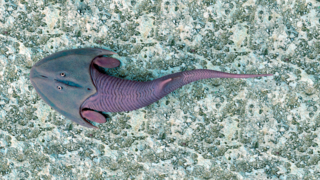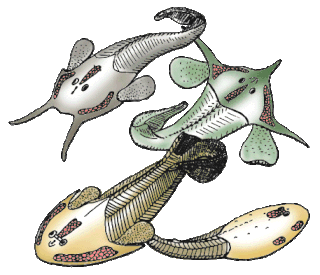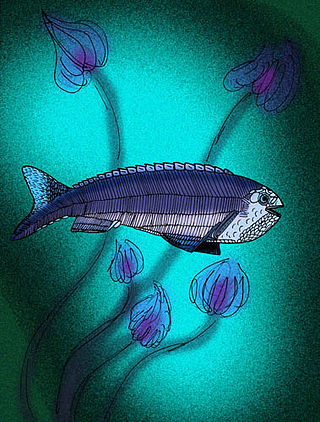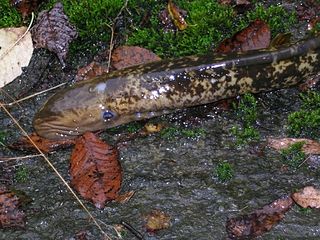
Agnatha is a paraphyletic infraphylum of non-gnathostome vertebrates, or jawless fish, in the phylum Chordata, subphylum Vertebrata, consisting of both living (cyclostomes) and extinct. Among recent animals, cyclostomes are sister to all vertebrates with jaws, known as gnathostomes.

Gnathostomata are the jawed vertebrates. Gnathostome diversity comprises roughly 60,000 species, which accounts for 99% of all living vertebrates, including humans. Most gnathostomes have retained ancestral traits like true teeth, a stomach, and paired appendages. Other traits are elastin, a horizontal semicircular canal of the inner ear, myelin sheaths of neurons, and an adaptive immune system which has discrete lymphoid organs, and uses V(D)J recombination to create antigen recognition sites, rather than using genetic recombination in the variable lymphocyte receptor gene.

Cephalaspidomorphs are a group of jawless fishes named for Cephalaspis of the osteostracans. Most biologists regard this taxon as extinct, but the name is sometimes used in the classification of lampreys, because lampreys were once thought to be related to cephalaspids. If lampreys are included, they would extend the known range of the group from the Silurian and Devonian periods to the present day. They are the closest relatives of jawed fishes, who may have emerged from within them; if this is true, they would survive if the jawed fish are included.

Ostracoderms are the armored jawless fish of the Paleozoic Era. The term does not often appear in classifications today because it is paraphyletic and thus does not correspond to one evolutionary lineage. However, the term is still used as an informal way of loosely grouping together the armored jawless fishes.

Anaspida is an extinct group of jawless fish that existed from the early Silurian period to the late Devonian period. They were classically regarded as the ancestors of lampreys, but it is denied in recent phylogenetic analysis, although some analysis show these group would be at least related. Anaspids were small marine fish that lacked a heavy bony shield and paired fins, but were distinctively hypocercal.

The class Osteostraci is an extinct taxon of bony-armored jawless fish, termed "ostracoderms", that lived in what is now North America, Europe and Russia from the Middle Silurian to Late Devonian.

Cyclostomi, often referred to as Cyclostomata, is a group of vertebrates that comprises the living jawless fishes: the lampreys and hagfishes. Both groups have jawless mouths with horny epidermal structures that function as teeth called ceratodontes, and branchial arches that are internally positioned instead of external as in the related jawed fishes. The name Cyclostomi means "round mouths". It was named by Joan Crockford-Beattie.

Cephalaspis is a possibly monotypic genus of extinct osteostracan agnathan vertebrate. It was a trout-sized detritivorous fish that lived in the early Devonian.

Boreaspis is an extinct genus of osteostracan agnathan vertebrate that lived in the Devonian period.

Ateleaspis is an extinct genus of primitive ostracoderm fish that lived in the Silurian period to the Lower Devonian. Like other ostracoderms, Ateleaspis had a head shield similar to that of Cephalaspis. Species from Silurian period were found in Norway and Scotland, but now has been found also in Siberia from Early Devonian period.

Benneviaspidida is an order of osteostracan jawless fishes which lived in the Early Devonian. The fishes in this order have a flat headshield and are dorsoventrally depressed. The first canal to lateral sensory field bifurcates near the orbit.

Auchenaspis salteri is an extinct species of armored jawless fish of the order Thyestiida from the Late Silurian of England. In England, A. salteri's fossils are found in extreme abundance in the Lower Old Red Sandstone strata in Ledbury, Herefordshire.

The evolution of fish began about 530 million years ago during the Cambrian explosion. It was during this time that the early chordates developed the skull and the vertebral column, leading to the first craniates and vertebrates. The first fish lineages belong to the Agnatha, or jawless fish. Early examples include Haikouichthys. During the late Cambrian, eel-like jawless fish called the conodonts, and small mostly armoured fish known as ostracoderms, first appeared. Most jawless fish are now extinct; but the extant lampreys may approximate ancient pre-jawed fish. Lampreys belong to the Cyclostomata, which includes the extant hagfish, and this group may have split early on from other agnathans.
This list of fossil fish species is a list of taxa of fish that have been described during the year 2012. The list only includes taxa at the level of genus or species.

Janaspis is an extinct genus of osteostracan, that lived in the early Devonian period in Britain. It is characterised by a number of features of its armoured headshield, including the presence of raised rims around its eyes, the shape of its lateral and median fields, its prominent dorsal spine, fairly long cornual processes and ornamentation. Janaspis was fairly small compared with other osteostracans, with a headshield measuring less than 60mm.

Zenaspidida is an extinct order of osteostracans, a group of jawless stem-gnathostomes. They possessed a distinct headshield, which varied in width to length ratio by species.

Zenaspididae is an extinct family of jawless fish in the order Zenaspidida.

Ateleaspididae is a prehistoric jawless fish family in the class Osteostraci.
This list of fossil fishes described in 2017 is a list of new taxa of jawless vertebrates, placoderms, acanthodians, fossil cartilaginous fishes, bony fishes and other fishes of every kind that are scheduled to be described during the year 2017, as well as other significant discoveries and events related to paleontology of fishes that are scheduled to occur in the year 2017. The list only includes taxa at the level of genus or species.
This list of fossil fishes described in 2020 is a list of new taxa of jawless vertebrates, placoderms, acanthodians, fossil cartilaginous fishes, bony fishes, and other fishes of every kind that were described during the year 2020, as well as other significant discoveries and events related to paleoichthyology that occurred in 2020.


















